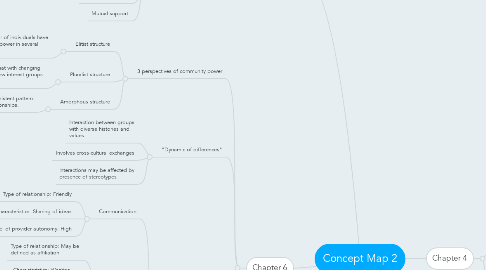
1. Chapter 4
1.1. Systems of Oppression
1.1.1. Ableism
1.1.1.1. Discrimination against individual who are considered physically or mentally incapable of functioning the same as others.
1.1.2. Ageism
1.1.2.1. Discrimination against an individual based on his or her age.
1.1.3. Classism
1.1.3.1. Discrimination against people of lower socioeconomic classes
1.1.4. Heterosexism
1.1.4.1. Discrimination against those who are (or are thought to be) lesbian, gay, bisexual, or transgendered.
1.1.5. Racism
1.1.5.1. Discrimination against someone based on his or her race.
1.1.6. Sexism
1.1.6.1. Discrimination against individuals based on their gender (esp. women).
1.2. Hypothesis of etiology
1.2.1. Hypothesis regarding the underlying causes of the problem at hand
1.2.1.1. Example: Adolescents are increasingly engaging in drug use because they feel neglected by parents.
2. Chapter 5
2.1. Community as defined by Weber (1978)
2.1.1. Organization of activities that allow access to things necessary for day-to-day living.
2.2. Five functions of community
2.2.1. Production, distribution, and consumption
2.2.2. Socialization
2.2.3. Social control
2.2.4. Social participation
2.2.5. Mutual support
3. Chapter 6
3.1. 3 perspectives of community power
3.1.1. Elitist structure
3.1.1.1. Assumes that a small number of individuals have disproportionate amount of power in several community sectors.
3.1.2. Pluralist structure
3.1.2.1. Implies that with changing issues, new interest groups arise.
3.1.3. Amorphous structure
3.1.3.1. Implies no consistent pattern of power relationships.
3.2. "Dynamic of differences"
3.2.1. Interaction between groups with diverse histories and values.
3.2.2. Involves cross-cultural exchanges
3.2.3. Interactions may be affected by presence of stereotypes
3.3. Five levels of interaction among service providers
3.3.1. Communication
3.3.1.1. Type of relationship: Friendly
3.3.1.2. Characteristics: Sharing of ideas
3.3.1.3. Level of provider autonomy: High
3.3.2. Cooperation
3.3.2.1. Type of relationship: May be defined as affiliation
3.3.2.2. Characteristics: Working together to plan/implement programs
3.3.2.3. Level of provider autonomy: High
3.3.3. Coordination
3.3.3.1. Type of relationship: Could be federation-, association-, or coalition- type relationship
3.3.3.2. Characteristics: Working with one another to avoid duplication and assist in information sharing, advertising, and referral making
3.3.3.3. Level of provider autonomy: Moderate
3.3.4. Collaboration
3.3.4.1. Type of relationship: Could be consortium, network, or joint venture
3.3.4.2. Characteristics: Joining to provide a single program with shared resources.
3.3.4.3. Level of provider autonomy: Moderate
3.3.5. Consolidation
3.3.5.1. Characteristics: Merge into one entity
3.3.5.2. Level of provider autonomy: autonomy relinquished
4. Chapter 7
4.1. Three forms of authority as described by Weber (1947)
4.1.1. Traditional authority
4.1.1.1. Right to govern that is bestowed on patrimonial leaders. This authority rests in rulers ancestral rights to control. Can be passed amongst generations.
4.1.2. Charasmatic authority
4.1.2.1. Dominance exercised through personal heroism, piety, martial skill, or other traits. Tend to be unstable and transitional.
4.1.3. Rational/legal authority
4.1.3.1. Power assigned based on ability to achieve goals. Derives from expertise and legitimacy given to rules rather than hereditary claims.
